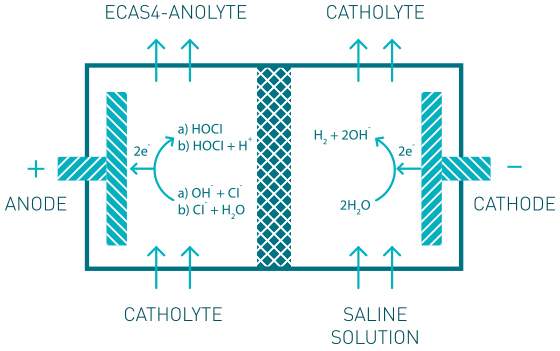Technology
Safe, ecological, water sanitisation systems
Electrolytic cells can be classified within two main categories: single-body cells, also called “undivided”, and cells with two (or more) bodies, otherwise called “membrane” or “diaphragm” cells.
As suggested by their name, the latter comprise a separator, which is required to physically separate the two electrode compartments, thus avoiding that what is produced in a compartment can diffuse toward the other, possibly reacting, with consequent drops in yield and/or changes in the desired products of the process.
Operation of a two-compartments cell
Example 1: each compartment is fed with the same initial solution, and two products (an Anolyte and a Catholyte) are obtained

Example 2: the solution processed in the first electrode compartment is fed to the second compartment, and a unique solution is thus obtained

Operation of the Ecas4® cell
The Ecas4® cell is substantially an evolution of the aforementioned membrane cell, which allows to avoid that what is produced at the anode (in this case, the active chlorine) may undergo reduction at the cathode (with obvious decreases in active chlorine production).
Thanks to the particular design of the Ecas4® cell (which has been patented), the incoming solution is first subjected to a cathodic treatment, and subsequently to two anodic treatments in series.
A part of the solution exiting the cathodic compartment is eliminated, and the anodic treatments are therefore carried out only on the main part of the catholyte. It is precisely this expedient that allows the production of a final solution having a pH close to neutrality.


The Ecas4-Anolyte solution has a high redox power and is genuinely pH neutral.
The Ecas4® apparatus is based on a Membrane Electrolytic Cell with four chambers.
The system allows the typical synthesis of a neutral Anolyte (with a pH close to 7) characterized by an Oxidation Reduction Potential (ORP) ≥ 900 mV and an active chlorine content of about 350 mg/L.
The Ecas4 technological advantage
- Ecas4-Anolyte is pH neutral
- Avoids the need to store dangerous chemicals
- 'Instantaneous' & 'residual' effects
- Removes existing biofilm from water mains pipes
- Approved bactericidal activity according to EN1276 & EN3697 of minimum 5 Log
- Environmentally friendly and non-toxic
- Fully complies with European legislation, including DVGW requirement (German Technical and Scientific Association for Gas and Water)
- Costs savings as thermal-shock treatment of pipes is no longer required
- Labour savings in industrial surface and machinery disinfection
- No chemical purchases required
- No special safety equipment or protocols required
- Systems can be designed according to client requirements
- Remote control capability
- Water treated remains potable
How Ecas4-Anolyte compares to other purification and disinfection systems
A minimal amount of Ecas4-Anolyte is injected into the water pipes - Suitable for warm & cold water.

